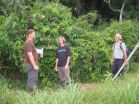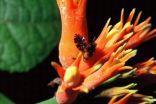(Press-News.org) The sun emitted a mid-level solar flare, peaking at 6:34 p.m. EDT on March 12, 2014, and NASA's Solar Dynamics Observatory, or SDO, captured an image of it. Solar flares are powerful bursts of radiation. Harmful radiation from a flare cannot pass through Earth's atmosphere to physically affect humans on the ground, however -- when intense enough -- they can disturb the atmosphere in the layer where GPS and communications signals travel.
To see how this event may impact Earth, please visit NOAA's Space Weather Prediction Center at http://spaceweather.gov, the U.S. government's official source for space weather forecasts, alerts, watches and warnings.
This flare is classified as an M9.3 flare, just slightly weaker than the most intense flares, which are labeled X-class. The letters denote broad categories of strength, while the numbers provide more information. An M2 is twice as intense as an M1, an M3 is three times as intense, etc.
This M9.3 flare was emitted by an active region — a magnetically strong and complex region on the sun's surface — labeled AR 11996.
Updates will be provided as they are available on the flare and whether there was an associated coronal mass ejection, or CME, another solar phenomenon that can send solar particles into space and affect electronic systems in satellites and on Earth.
INFORMATION:
Mid-level solar flare seen by NASA's SDO
2014-03-13
ELSE PRESS RELEASES FROM THIS DATE:
Halting immune response could save brain cells after stroke
2014-03-13
MADISON — A new study in animals shows that using a compound to block the body's immune response greatly reduces disability after a stroke.
The study by scientists from the University of Wisconsin School of Medicine and Public Health also showed that particular immune cells – CD4+ T-cells produce a mediator, called interleukin (IL) -21 that can cause further damage in stroke tissue. Moreover, normal mice, ordinarily killed or disabled by an ischemic stroke, were given a shot of a compound that blocks the action of IL-21. Brain scans and brain sections showed that the ...
Condon publishes new research in Science
2014-03-13
A wasp's sting might explain it all.
Marty Condon, professor of biology at Cornell College, has been studying flies in the tropics for years, and in a paper published in Science this week, she reports evidence that there is more to a fly's ecological niche than where it lives and what it eats—you have to look at what eats the fly, as well.
In a previous Science paper, Condon and her co-researchers found that there were far more species of flies feeding on tropical flowers than expected. It was counter-intuitive, Condon said, to see so many species of flies filling what ...
Scripps Florida scientists devise new, lower cost method to create more usable fuels
2014-03-13
JUPITER, FL – March 13, 2014 – As the United States continues to lead the world in the production of natural gas, scientists from the Florida campus of The Scripps Research Institute (TSRI) have devised a new and more efficient method with the potential to convert the major components found in natural gas into useable fuels and chemicals—opening the door to cheaper, more abundant energy and materials with much lower emissions.
The research, which was led by TSRI Professor Roy Periana, uses clever chemistry and nontraditional materials to turn natural gas into liquid ...
Scripps Research Institute scientists discover a better way to make unnatural amino acids
2014-03-13
LA JOLLA, CA—March 13, 2014—Chemists at The Scripps Research Institute (TSRI) have devised a greatly improved technique for making amino acids not found in nature. These "unnatural" amino acids traditionally have been very difficult to synthesize, but are sought after by the pharmaceutical industry for their potential medical uses.
"This new technique offers a very quick way to prepare unnatural amino acids, many of which are drug candidates or building blocks for peptide drugs," said Jin-Quan Yu, a professor in TSRI's Department of Chemistry.
Yu's team has reported ...
Scientists find new way to upgrade natural gas
2014-03-13
America's current energy boom may take a new direction thanks to the discovery of a new way to turn raw natural gas into upgraded liquid alcohol fuel.
In the March 14 issue of Science magazine, chemists from Brigham Young University and The Scripps Research Institute detail a process that could reduce dependence on petroleum.
The most unexpected breakthrough in the paper was that ordinary "main group" metals like thallium and lead can trigger the conversion of natural gas to liquid alcohol. The research teams saw in experiments that natural gas to alcohol conversion ...
Stumbling fruit flies lead scientists to discover gene essential to sensing joint position
2014-03-13
LA JOLLA, CA—March 13, 2014—Scientists at The Scripps Research Institute (TSRI) have discovered an important mechanism underlying sensory feedback that guides balance and limb movements.
The finding, which the TSRI team uncovered in fruit flies, centers on a gene and a type of nerve cell required for detection of leg-joint angles. "These cells resemble human nerve cells that innervate joints," said team leader Professor Boaz Cook, who is an assistant professor at TSRI, "and they encode joint-angle information in the same way."
If the findings can be fully replicated ...
A novel battleground for plant-pathogen interactions
2014-03-13
Scientists at The Sainsbury Laboratory in Norwich, with collaborators at Michigan State University and the University of Illinois, have unveiled a new way in which plants perceive pathogens to activate immunity.
They also show how pathogens inhibit the mechanism to cause disease. It was previously only associated with other processes in mammalian cells.
When plants detect microbial molecules, they trigger immune responses to prevent disease. Although several plant immune receptors for these microbial molecules are known, how they are activated once the microbe is recognised ...
When big isn't better: How the flu bug bit Google
2014-03-13
Numbers and data can be critical tools in bringing complex issues into crisp focus. The understanding of diseases, for example, benefits from algorithms that help monitor their spread. But without context, a number may just be a number, or worse, misleading.
"The Parable of Google Flu: Traps in Big Data Analysis" is published in the journal Science, funded, in part, by a grant from the National Science Foundation. Specifically, the authors examine Google's data-aggregating tool Google Flu Trend (GFT), which was designed to provide real-time monitoring of flu cases around ...
More to biological diversity than meets the eye
2014-03-13
Most of us already imagine the tropics as a place of diversity—a lush region of the globe teeming with a wide variety of exotic plants and animals. But for researchers Andrew Forbes and Marty Condon, there's even more diversity than meets the eye.
In a paper published in the March 14 issue of the journal Science, Forbes and Condon report the discovery of extraordinary diversity and specialization in the tropics.
The paper builds upon previous research conducted by Condon, who discovered surprising diversity while researching plant species in South America. Later, she, ...
Saving large carnivores in the ecosystem requires multifaceted approach
2014-03-13
Carnivore management is not just a numbers game, Virginia Tech wildlife scientists assert in response to an article in the Jan. 10 issue of the journal Science that urged "minimum population densities be maintained for persistence of large carnivores, biodiversity, and ecosystem structure."
"This type of approach may fail in social carnivore species," said Kathleen Alexander, an associate professor of fisheries and wildlife conservation in the College of Natural Resources and Environment. "Predator management is incredibly complex and we need to be extremely cautious ...






